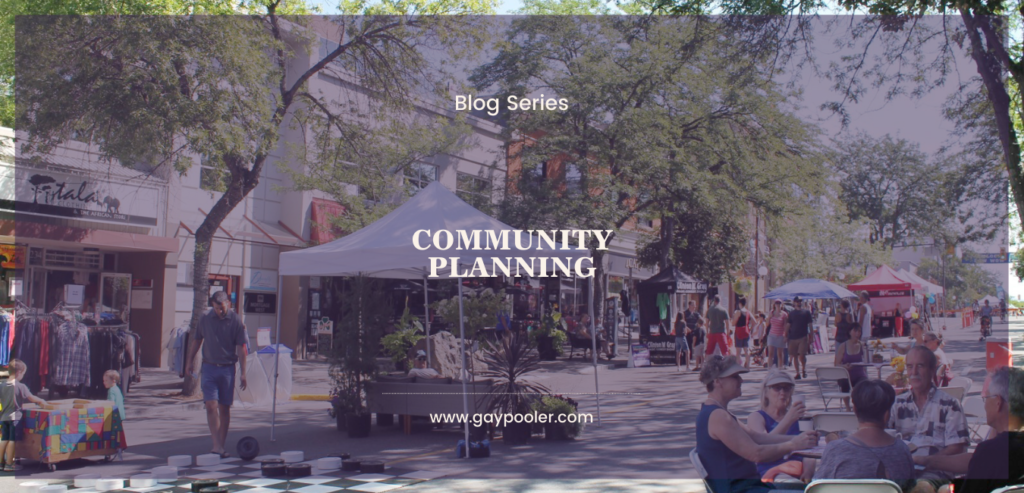Community Planning

Community Planning does not rest on the shoulders of one entity.
There are many people, businesses and organizations that must work together to develop a community.
Neighbourhood Plans
Developing neighbourhood plans takes a substantial amount of time. You must involve everyone who uses the neighbourhood: Businesses, residents, and visitors.
Business Improvement Associations have a role to play.
-Facilitating conversations; bringing businesses together with each other and with residents.
-Surveying visitors; online and on the street.
-Be the bridge between the city and the business community.
-Stay connected with the process; sit on the City planning committee and have frequent conversations with city staff and council.
And finally, when reaching the critical stages, advocate strongly for the priorities identified by your businesses. The community planning process is a rare opportunity – capitalize on it!
Place Making – develop a plan
If the destination is not worth the journey, you have wasted the effort and money put into enticing people to come. This is the key principle of destination development. Place management is an important part of creating dynamic places. If you want to be successful with place management, you need a plan.
Things to consider:
- What is possible? Looking at logistics like street design, access to power, space, funding available, regulations, storage.
- Who will do it? Management, set-up, take down. You need staff resources.
Elements of the plan:
- Place: “Found” spaces: not every downtown has the perfect gathering space to use for place management so you must look for smaller spaces that can be used. These can be a combination of public, semi-public, and privately owned spaces.
- Permits: Getting the city on side with your plan is a first step. Some are more open to it than others. Sometimes you must get creative. For example, permits created for temporary use of sidewalks for special events can be applied for with a date range covering your entire summer season. This way the BIA and its merchants can use the sidewalks under one permit and insurance.
- Partnerships: Create merchant buy-in. Permit acquisition is a start; explain the benefits to both their business and the downtown as a whole. Encourage them to utilize the sidewalks for business displays, seating, planters etc. They could also adopt activation equipment such as games or bistro sets. Other businesses may have storage available. Yoga or dance studios can do outdoor demos and workshops.
- Programming: An intentional, interactive programming plan will make all the difference. Live music, street performances, games big and small – giant Jenga or checkers, tables with chess and other board games, photo cut-out boards and more. Be creative, one time I built a giant five-foot, plywood cactus with pegs sticking out and rope loops to throw onto the pegs. People loved it. Simple works.
Public space management is one of my passions. Creating dynamic places is challenging and rewarding,https://www.gaypooler.com/contact/#formcontact me for a consultation on developing a plan for your town.
Learning from others – Even of a different scale
When I travel, I am always observing and learning, looking at how places are designed, how people utilize those spaces and how they are activated; organically and/or purposeful. I continually take photos, make notes, and write stories (see my blogs).
Even though other cities may be very different from yours you can still learn from them. Seize on a good idea, then take pieces that can be used. Sometimes it is just a small bit, or it simply needs to be scaled down to suit.
When you see another city that has success with a program or project it is inspiring, it feeds your drive to get yours done.
When you are advocating for funding or changes needed you can point to what others have done successfully.
When my BIA associate and I went to New York for a conference, we were incredibly inspired by what we saw. Examples of public space activation in particular. Who would have thought that something done in New York City could instigate new programs and activities in Kamloops! Well, it sure did; we developed and launched a comprehensive place management plan for Downtown that created visible vibrancy in the area.
Learning from others is smart; don’t reinvent the wheel, just rearrange the spokes!
Place Management 101 in Wetumpka
Full disclosure here, I am a bit of an HGTV addict. Love the idea of makeovers! But I really got excited when The TV show Home Town Takeover did a complete makeover of a shopping street in Downtown Wetumpka, Alabama. A place management professional’s dream come true. Everything from overhead powerlines removed to repainting all the building facades, cohesive signage, sidewalk seating, and even a “parklet” created. They considered the key ingredients for a successful downtown and followed the principles of collaboration, design, curb appeal, overall aesthetics and functionality.
This is what a town winning the lottery looks like!
An Urban Place Management Star!
Kensington BRZ in Calgary has been a consistent trailblazer in the BIA world. Their leading role in both the Surplus Parking revenue sharing program and the COVID driven Task Force that resulted in the City of Calgary paying the BIA levy for businesses in 15 BIA’s is a perfect example of rising waters lifting all boats.
Leading Kensington BRZ for almost 20 years, Annie MacInnis is someone you have to work hard to keep up to, but she inspires you to give it your best shot. First time I met her was at a conference in New York City, where we went exploring and shopping together. So much fun, but on the serious side here is a great story about the BIA’s role in the growth and success of Canada’s Main Streets, which features an interview with Annie and highlights Kensington >>> read more here.
BIA’S and Tourism Marketers natural partners in Destination Development.
When you look at the mandates of both Tourism marketing groups and Business Improvement Associations (BIA’s), they share many similar goals. To entice people to visit and stay over, thus spending money in their town. The strategies they each use to achieve those goals and the specific market they can reach are different. That is a good thing. Working in tandem these organizations can achieve much more than if they are working in separate silos.
The BIA is best to concentrate on the hyper local market, improving the product, creating a place the locals love and want to spend time in, making it notable. The Tourism group can pick up that ball and run with it, marketing the “product” to a wider audience. The Businesses within that area benefit from those leveraged marketing dollars. They have invested a modest amount through the BIA levy and reaped a good return on investment.
As I mentioned earlier, the destination must be worth the journey to get there, or people will not return or refer their friends. It will be worth it if both organizations do their part.
If you are a small town working on economic recovery, my advice would be to start with a good look at what you have and what you can do to improve. And remember the adage about a perspective from outside looking in is where you will learn the most. Who you have available is also key. A small group of committed community champions is a positive base to launch with.
For more information on workshops, services, and training for your Board of Directors, contact me here.
~GP









